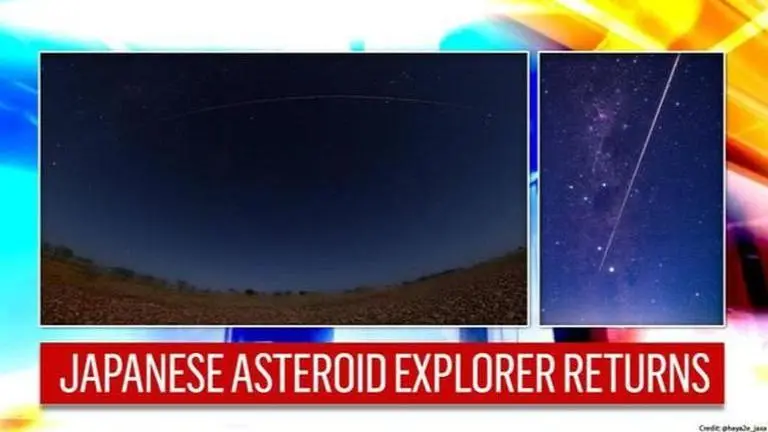Updated 6 December 2020 at 12:55 IST
Japan's Hayabusa2 capsule lands with asteroid dust samples in Australian desert
Japanese unmanned spacecraft ayabusa2 returned back to earth after six years in space with samples collected from an asteroid
- Science News
- 3 min read

Japanese unmanned spacecraft Hayabusa2 returned back to earth after six years in space with samples collected from an asteroid. The official Twitter handle of Hayabusa2, on December 5, posted hourly updates of the spacecraft and its progress. The samples which have been collected by the spacecraft are expected to contribute on topics like the origin of life and the formation of the universe.
Asteroid dust arrives on Earth
“Due close proximity to the Earth, the spacecraft was invisible to the ground antenna and communication was interrupted. However, communication with the Goldstone station began again at 03:15 JST. This elicited a big applause in the control room!”, read a tweet. As per a tweet, at 01:57 JST, the spacecraft has entered the Earth's shadow. Another tweet revealed that the speed of the aircraft will tend to increase after 02:30, reaching a maximum of about 11.7 km/s. As the spacecraft came closer, members in the control room were increased. The official Twitter handle also shared images of the control room.
[Capsule Separation Operation] More views from the control room today. The top right photo shows the image when the Gate Check is confirmed, and the next photo will show the screen before we are GO... pic.twitter.com/uUaVTnj7qp
— HAYABUSA2@JAXA (@haya2e_jaxa) December 5, 2020
[Capsule Separation Operation] Photograph of when permission to execute TCM-5 was obtained from the Commonwealth Return Safety Officer (CRSO). Dominic Balasuriya of the Australia Embassy is on the right, Project Manager Yuichi Tsuda is on the left. pic.twitter.com/JeXa5ImwwD
— HAYABUSA2@JAXA (@haya2e_jaxa) December 5, 2020
Even if the mission was successful, the work has not come to an end as of now. Hayabusa2 is expected to work on an extended mission of targeting two new asteroids. It will be moving towards its first target, 1998 KY26, which is a ball shaped asteroid, with a diameter of 30 metres.
Advertisement
We found the capsule!
— HAYABUSA2@JAXA (@haya2e_jaxa) December 5, 2020
Together with the parachute!
Wow!
(Collection Team M)#Hayabusa2#はやぶさ2#AsteroidExplorerHayabusa2 #HAYA2Report
We observed the capsule re-entry from around Coober Pedy, with the assistance of Curtin Observatory. The observation was successful & here is our image!https://t.co/KTdV0G9moU
— HAYABUSA2@JAXA (@haya2e_jaxa) December 6, 2020
Credit: Curtin University, Kouchi University of Technology, Nihon University, Ibaraki University, JAXA pic.twitter.com/qTFW8I8UD9
During the important mission, the Hayabusa2 department wrote that they were connected to the DSN and the United States. The tweet read, “Project Manager Tsuda informed the DSN that the capsule separation was successful and received their congratulations”. The Desert fireball network made an observation of the capsule’s re-entry over South Australia. According to the official website, the network, along with Kochi University of Technology (KUT) and their partners at Nihon University and Ibaraki University, are deploying ‘a large array of over 50 instruments to capture the effects of this exceptional phenomenon’.
Advertisement
Hayabusa2 reached the Ryugu asteroid in June 2018 and descended on the asteroid’s surface on February 2019. It then fired a small projectile into the ground and scooping surface material into a container. The spacecraft then fired an impactor into the asteroid from a distance, thereby forming a small crater in April 2019. In July 2019, it swooped down again in to grab material ejected by the impact. Hayabusa2 finally left its orbit around the asteroid in November 2019 to begin its return journey.
(Image Credits: @haya2e_jaxa)
Published By : Akanksha Arora
Published On: 6 December 2020 at 12:54 IST
